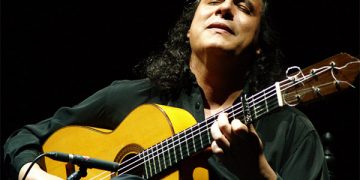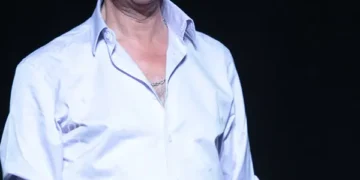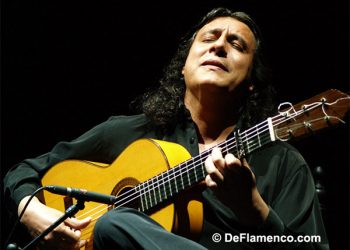|
| Daily coverage BIENAL DE FLAMENCO sponsored by: |
Cante: Segundo Falcón. Guitar: Paco Jarana, Salvador
Gutiérrez. Percussion: Antonio Coronel. Chorus and palmas:
Jeromo Segura, Vicente Gelo, Inmaculada Rivero. Orquesta Chekkara:
Jallal Chekkara, Yousser El Hosseieni, Fathi Ben Yakoub, Youssef
El Mezguildi, Mouhssine Korachi, Ahmed Ahnin. Orquesta Mharahá:
Barkat Khan, Bachu Khan, Husain Khan, Mustak Khan.
Admirably, Seville’s Bienal de Flamenco makes a point
of offering a wide range of shows for all tastes, from the most
traditional sort of cante, to the most avant-garde fusion. Therefore,
the person whose job it is to attend the various presentations night
after night to comment on them the following day, must maintain
a strictly open and tolerant attitude.
Nevertheless it was with the greatest apprehension this reviewer
showed up last night at the Hotel Triana, a venue that was formerly
a collective urban dwelling with large central patio, now remodeled
to serve as open-air theater, determined to put up with a show that
could not possibly please someone with a taste for straightforward
unadulterated flamenco. There was no choice – sentences would have
to be found that neither condemned nor praised in order to communicate
the nature of the show without revealing personal opinions.
The Triana air filled with insolent
sounds and music that was absolutely seductive
So it came as a shock when the first vibrations of the Mharahá
de Rajasthan Orchestra, the “Gypies of Rajasthan” as
they called themselves for a tour of the US and Europe, fell upon
inner ears accustomed to sounds that are more…Andalusian?…western?
Without a second thought these exotic people sat down and filled
the Triana air with insolent sounds and music that was absolutely
seductive for the untrained listener. Is this perhaps the effect
flamenco has on people who hear it for the first time? Four individuals,
three voices, immediately oblige us to acknowledge the universality
and power of their music.
The group remains on stage as the Chekkara Orchestra of Tetuán
appears. The North African sound is more familiar due to the cultural
and geographic proximity of North Africa to Spain, not to mention
the radio waves that cross the Strait bringing exotic sounds from
the south. The lesson continues however and we’re learning
something we’ve always instinctively known: music is the most
perfect common language.

Finally Segundo Falcón appears with his group, the most
noteworthy member being guitarist Paco Jarana, husband of Eva Yerbabuena
and the singer’s regular guitarist. Now we feel right at home,
but the sounds of the first cante, a granaína, are received
from another perspective after listening to the other two groups
who observe, smiling broadly, showing their profound respect. Being
a musician is the first nationality of these men, and seldom has
such a sophisticated concept been expressed so eloquently without
a single word.
Authentic fusion without cultural assault
or commercial gimmicks
With the stage laid out in this fashion, the formula keeps working
for a series of numbers in which the groups alternate and communicate,
especially in the percussion – they’re having a good
time and we get to watch and listen. It’s of great help that
Segundo Falcón’s voice isn’t the typical rough
“afillá” voice we associate with cante, but a
sweet clean voice that sounds little different from the others.
Deprived of their colorful costumes, turbans, chilabas, sandals,
it becomes one great unified orchestra, authentic fusion without
cultural assault or commercial gimmicks.
The rich buffet of sounds is administered with absolute wisdom.
A rhythm in four quarter time is answered with tangos, three quarter
time brings rondeña, caña or bulerías where
each one puts several grains of sand. Minor key instigated by the
Chekkara Orchestra is answered by Segundo’s tangos del Piyayo,
and the Indian musicians add something similar of their own as well.
One wonders what the fiesta final will be… A couple of people
up on stage doing palmas for Segundo could do their regular bit,
but no one is showing off, the magic would be lost. The show is
wrapped up with cantiñas with each group having a say in
a musical-cultural orgy that enthralls the audience and gets them
to their feet. The obligatory curtain call is a round of…no,
not tonás. Segundo Falcón and the lead singers from
the other two groups approaches the front edge of the stage and
without mikes they take turns singing a capella.
There are still things to be invented under the sun…in music,
even moreso.
Texto y foto: Estela
Zatania
|
|
Related products:
|
























